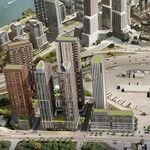Tuesday, May 26, 2009 04:28 PM
Andrew Steele
The recent decision by the pro-David Miller majority on Toronto City Council to file an application for an environmental assessment on reducing the number of car lanes on Jarvis in order to provide dedicated lanes for bikes is a fascinating example of political mathematics.
A few fast facts are needed to understand the calculation.
First, voter turnout in past Toronto municipal elections was abysmal. In 2006 it was just 39.3 per cent. Prior to that, the electoral list included as many as 300,000 ineligible voters, making true comparisons impossible, but we can say conclusively it was terrible.
Second, 2 per cent of Toronto commuters routinely travel by bicycle .
Third, David Miller will face no credible opponent to his left. However, he may face multiple credible opponents to his right.
Now, let’s apply those facts to the situation.
First of all, in a low turnout election, you can win with the support of just 20 per cent of the population (that’s half the vote in an election where 40 per cent turn out.) With the multiple minor candidates and typically several credible ones, typically a candidate can win with significantly less.
The challenge in a low turnout election is not getting a disinterested and low-information mushy middle voter to cast their ballot for you when they trudge to the polls to exercise their duty. It is to motivate groups of voters who are likely to vote for you to go to the polls at all.
As such, it is critical to assemble an idea of what you want your coalition to look like well before the election, and then set about energizing those voters to cast ballots.
Bike commuters are a part of Miller’s planned coalition. Some others include public sector union members, transit commuters, renters, downtown residents, new Canadians, environmental voters, and a number of additional segments.
But bike commuters are only 2 per cent of the population, you say. That’s hardly worth going after.
In an election where only 40 per cent of the electorate votes, 2 per cent of the population – if it turns out to vote en masse – is actually 5 per cent of the electorate. That is a pretty big bloc of voters; equivalent to, say, Manitoba in a federal election.
Again, in a low turnout election, the challenge is not that the group seems small. It is that they must be highly motivated.
It is reasonable to expect that those bikers, who put their safety on the line every day to get to work, can be motivated with an emotional appeal to their commuting experience. It is also reasonable to assume that championing their safety in a high-profile confrontation will make these commuters highly motivated to both turn out to vote, and to vote for their champion.
As a result, Mayor Miller wanted to polarize the situation into one where he was the champion of the bike commuters and his potential opponents – councilors like Denzil Minnan-Wong and Karen Stintz - were off-side with bike commuters. This is a good move for Candidate Miller because it helps motivate 5 per cent of the electorate.
By creating a high-profile stand-off over the Jarvis situation, he did that. Most bike commuters noticed the confrontation as part of a pattern of earlier and future efforts to win over bikers. And as they get closer to the election, Miller’s campaign will work to ensure that – for those voters – it is a simple ballot question: David Miller is keeping me safe; those other guys are going to get me hit by a car.
In addition, those most offended by the issue were the wealthy commuters of Moore Park and Rosedale. This is a group that is a base to any coalition of voters that will coalesce around his pro-business opponents. Keep in mind, the decision yesterday was to launch an environmental assessment to alter Jarvis. It is unlikely the lane reduction will actually be in effect by the date of the election (unless Miller pushes it.) This means those impacted by the decision won’t feel the effects, thus remaining less engaged and less outraged about the issue.
More importantly, the Jarvis issue angers a very tiny and regionally clustered segment of potential voters in those regions. But the city-wide bike commuter community is watching and likely voting accordingly. Again, if you bike to work, that is probably your voting issue municipally. But if you drive to work, you may vote on property taxes, or airport bridges, or potholes, or any old thing.
Miller’s opponents will try to mobilizes opponents of the Jarvis route change. But with no tangible impact yet felt, it will be an uphill battle. And the harder they press, the more they motivate the bike commuters to vote for Miller.
Expect this pattern to play out for the next eighteen months.
With no opponent to his left, Miller can seize the left pole of any issue. He is then free to polarize and energize the electorate as he chooses.
In contrast, his likely opponents have a very unclear picture of potential challengers to their right or in the centre between them and Miller. They have less range of motion on issues and are instead adopting a reactive “oppose everything†stance that is an unavoidable mistake.
The two most likely candidates – Karen Stintz and Denzil Minnan-Wong – are both city councilors who are falling into the opposition mentality: if Miller does it, I oppose it. The result is they are constantly falling into these traps laid by Miller, playing the foil so he can energize blocs of voters into his coalition.
Until someone gets out of the City Council hot house and runs on his or her own terms with a positive agenda for change, the opposition to Miller is only feeding him.
















